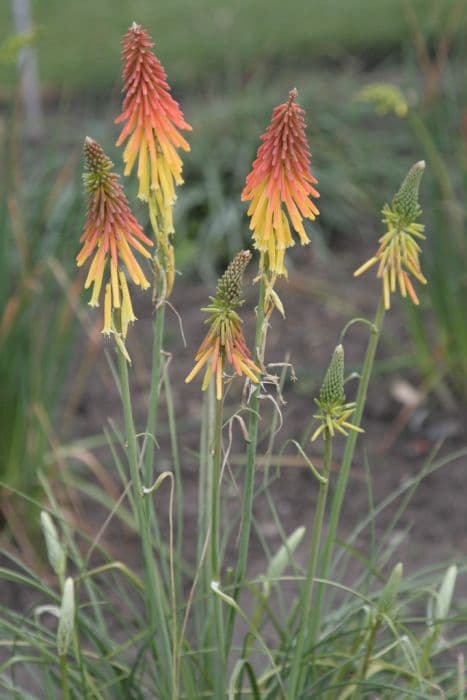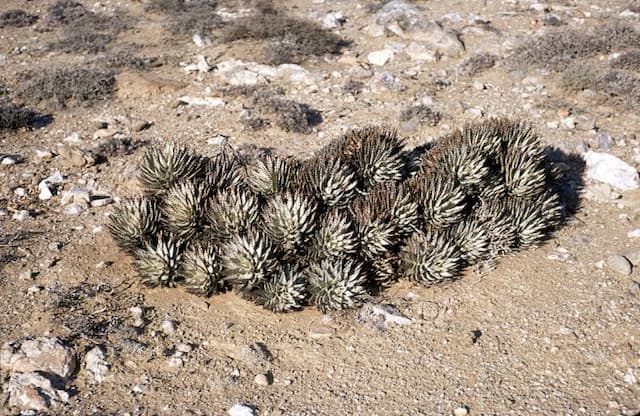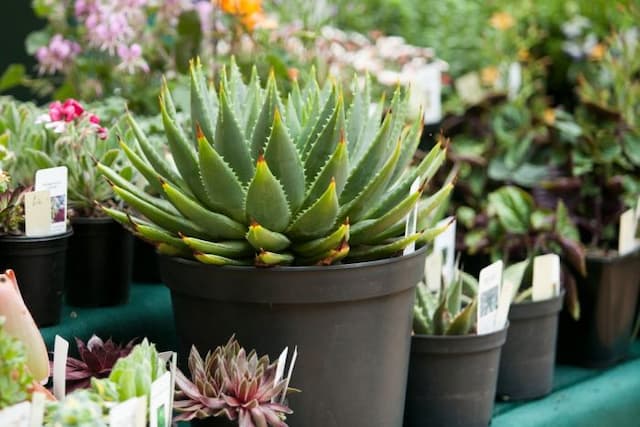Red Hot Poker Kniphofia 'Bressingham Comet'

ABOUT
Kniphofia 'Bressingham Comet', commonly known as Red Hot Poker, is a perennial plant that boasts distinctive flower spikes, adding a dramatic flair to gardens. The Red Hot Poker plant has grass-like, long, slender leaves that create an arching, clumping form, providing a lush green backdrop for the vibrant flower spikes. These leaves can be quite stiff and pointed. The most notable feature of the Red Hot Poker 'Bressingham Comet' is its striking flower spikes. These conical inflorescences consist of tubular blooms that create a fiery gradient of color as they mature. The flowers typically transition from a warm, creamy hue at the top to a vibrant orange-red towards the base, reminiscent of a flickering flame. The gradient effect is due to the staggered opening of the flowers, with the blooms at the bottom of the spike maturing first. The floral display occurs on sturdy, upright stems that rise above the foliage, attracting both visual interest and pollinators like bees, butterflies, and hummingbirds to the garden. These blooms can also make for striking cut flower arrangements. The contrast between the cool green foliage and the hot-colored flower spikes gives the 'Bressingham Comet' a reputation as a bold and exotic addition to any landscape.
About this plant
 Names
NamesFamily
Asphodelaceae
Synonyms
Red Hot Poker, Torch Lily, Tritoma
Common names
Kniphofia 'Bressingham Comet'
 Toxicity
ToxicityTo humans
Red hot poker, which is the common name of Kniphofia 'Bressingham Comet', is not widely known to be toxic to humans. There is little to no documentation on systemic toxicity following ingestion by humans. However, it is generally advisable to avoid consuming parts of ornamental plants given that they are not intended for human consumption, and individuals may have varying sensitivities or allergic reactions. If ingested, it may cause mild stomach upset or skin irritation for some individuals due to its saponin content. If any part of the plant is consumed and symptoms develop, medical advice should be sought.
To pets
Red hot poker is the common name for Kniphofia 'Bressingham Comet'. This plant is not commonly listed as toxic to pets like cats and dogs. There is limited information available on severe poisoning or toxicity resulting from ingestion by pets, but as with many ornamental plants, it could potentially cause gastrointestinal upset such as vomiting or diarrhea if ingested. One should always monitor pets and prevent them from eating ornamental plants, as their reactions can be unpredictable. If a pet does consume red hot poker and exhibits adverse symptoms, it is important to consult a veterinarian.
 Characteristics
CharacteristicsLife cycle
Perennials
Foliage type
Evergreen
Color of leaves
Green
Flower color
Mixed
Height
3 feet [0.91 meters]
Spread
2 feet [0.61 meters]
Plant type
Herb
Hardiness zones
5
Native area
South Africa
Benefits
 General Benefits
General Benefits- Attracts pollinators: Kniphofia 'Bressingham Comet', commonly known as Red Hot Poker, attracts bees, butterflies, and hummingbirds, contributing to a healthy ecosystem.
- Drought tolerant: Once established, Red Hot Poker is tolerant of drought, making it a suitable choice for water-wise gardens.
- Low maintenance: It requires minimal care once established, making it an easy choice for gardeners of all skill levels.
- Long blooming period: Offering a long season of color with its vibrant flowers, which can bloom from late spring to early autumn.
- Aesthetic appeal: With its unique, fiery-colored spikes of flowers, it adds dramatic flair and visual interest to garden beds, borders, and containers.
- Deer and rabbit resistant: Its foliage and flowers are typically resistant to browsing by deer and rabbits, reducing the need for protective measures.
- Versatile planting options: Suitable for various garden designs, including cottage gardens, coastal gardens, and contemporary landscapes.
- Soil adaptability: Red Hot Poker can thrive in a range of soil types, although it prefers well-draining soil.
 Medical Properties
Medical PropertiesThis plant is not used for medical purposes.
 Air-purifying Qualities
Air-purifying QualitiesThis plant is not specifically known for air purifying qualities.
 Other Uses
Other Uses- Decorative Dried Flower - Kniphofia 'Bressingham Comet', commonly known as Red Hot Poker, can be dried and used in floral arrangements for its unique shape and texture, offering a long-lasting alternative to fresh blooms.
- Textile Dyeing - The vibrant colors of the Red Hot Poker's flowers can be used to produce natural dyes for coloring textiles, giving fabrics a unique and organic hue.
- Garden Sculpture - The architectural form of the Red Hot Poker can be integrated into garden designs as a natural sculpture, providing height and visual interest throughout the year.
- Educational Tool - Red Hot Poker can serve as an educational specimen in botany classes to study flower anatomy and pollination strategies adapted by perennial plants.
- Photography Subject - The dramatic flowers of Red Hot Poker make it a popular subject for garden photographers and nature enthusiasts looking to capture its fiery blooms.
- Marker Plant - Red Hot Poker can be used as a marker plant to indicate the locations of less visible, shorter perennials in a mixed flower bed when they are not in bloom.
- Theme Gardens - This plant can play a pivotal role in fire-themed gardens or in plantings that aim to represent the warm spectrum of the color wheel through flowers.
- Companion Planting - Red Hot Poker can be used in companion planting to attract pollinators and beneficial insects that might benefit surrounding vegetables or fruit-bearing plants.
- Erosion Control - The root systems of Red Hot Poker can help stabilize soil in sloped gardens or areas prone to erosion, while adding aesthetic appeal.
- Cultural Festivities - In some regions, the striking blooms of Red Hot Poker may be included in floral displays during cultural festivals or celebrations as a symbol of strength and vibrancy.
Interesting Facts
 Feng Shui
Feng ShuiThe Red Hot Poker is not used in Feng Shui practice.
 Zodiac Sign Compitability
Zodiac Sign CompitabilityThe Red Hot Poker is not used in astrology practice.
 Plant Symbolism
Plant Symbolism- Standing Out: Red hot poker plants are known for their striking flower spikes that stand out in a garden, symbolizing the idea of being unique or attracting attention.
- Intensity: The vibrant colors transitioning from red to orange to yellow can symbolize intense emotions, passion, or a vibrant personality.
- Energy: Their fiery appearance and bright hues often represent high energy or activity, much like the dynamic nature of fire.
- Attraction: Known for attracting hummingbirds and butterflies, red hot poker plants can symbolize allure and the ability to attract others to you.
- Courage: The bold and vivid presence in a landscape can symbolize the courage to stand out and be visible.
 Water
WaterThe Red Hot Poker should be watered deeply once a week, allowing the soil to dry out slightly between waterings. Each watering session should consist of about 1-1.5 gallons of water per plant, ensuring that the water penetrates deeply into the soil to reach the roots. During hot, dry spells, you may need to increase the frequency to twice a week, especially for plants in full sun. It is important not to overwater, as this can lead to root rot. Ensure that the plant's soil is well-drained to prevent water from pooling around the base.
 Light
LightThe Red Hot Poker thrives in full sun exposure, which means it should receive at least 6 to 8 hours of direct sunlight daily. The ideal spot for planting is an area with clear access to the day's sun, away from larger plants or structures that could block light. While it can tolerate some partial shade, flowering is best in full sun conditions.
 Temperature
TemperatureThe Red Hot Poker can tolerate a range of temperatures from about 5°F to 90°F but prefers a climate where temperatures consistently stay between 50°F and 75°F. While it can survive minor frost, prolonged exposure to temperatures below freezing can be detrimental to the plant. The Red Hot Poker is well-suited for growth in USDA hardiness zones 5 through 9, which correspond to its temperature tolerance.
 Pruning
PruningPruning the Red Hot Poker is necessary to remove spent flower stalks and to maintain its attractive appearance. Deadheading or removing the old flower spikes after blooming encourages the plant to produce more flowers. Cut the stalks at the base once they have finished flowering. Additionally, in the spring, prune away any dead foliage from the previous season to make way for new growth.
 Cleaning
CleaningAs needed
 Soil
SoilThe Red Hot Poker (Kniphofia 'Bressingham Comet') prefers well-draining, fertile soil with a pH range of 6.0 to 6.5. A good soil mix for this plant would contain loam, compost, and sand or perlite to ensure adequate drainage. Amend the soil with organic matter to provide the necessary nutrients.
 Repotting
RepottingRed Hot Poker plants typically do not require frequent repotting. They can be left undisturbed for years unless the clumps become overcrowded. If needed, repot or divide the clumps in the spring every 3-5 years to keep the plant healthy.
 Humidity & Misting
Humidity & MistingRed Hot Poker plants prefer average humidity levels and do not have special humidity requirements. They are adaptable to the humidity found in most outdoor garden environments without the need for additional humidity control.
 Suitable locations
Suitable locationsIndoor
Bright light, minimal water, well-draining soil, regular feeding.
Outdoor
Full sun, well-drained soil, low to moderate water.
Hardiness zone
5-9 USDA
 Life cycle
Life cycleThe life of Kniphofia 'Bressingham Comet', also known as Red Hot Poker, Torch Lily, or Poker Plant, begins with seed germination, where warmth and moisture trigger the growth of new plants. The seedlings emerge and establish a basal rosette of long, narrow leaves, entering a vegetative growth phase to build a strong root system and foliage. During spring or summer, the plant enters its flowering stage, where tall, sturdy flower spikes arise from the rosette, blooming with bright red to orange tubular flowers that are attractive to hummingbirds and other pollinators. After pollination, the plant sets seed which may self-sow or be collected for propagation. In the perennial phase, foliage may die back in the winter, especially in cooler climates, while the root system remains alive to send up new growth the following season. With proper care, Kniphofia 'Bressingham Comet' will continue this cycle yearly, growing in size and producing more flower spikes each year.
 Propogation
PropogationPropogation time
Spring to early summer
Kniphofia 'Bressingham Comet', commonly known as Red Hot Poker, is generally propagated by division, which is the most popular method for this perennial plant. The best time to divide Red Hot Poker plants is in the spring after the danger of frost has passed but before new growth has begun in earnest. To propagate by division, carefully dig up an established clump and gently separate it into smaller sections, each with a good amount of roots and at least one or two growing points. These sections can then be replanted in a well-draining soil mix, making sure that the crowns are set at the same level they were in the original planting. It is important to keep the newly planted divisions well-watered until they are established, which usually takes several weeks.









